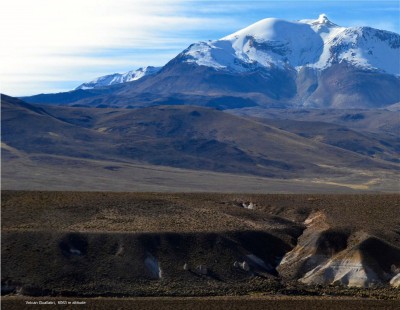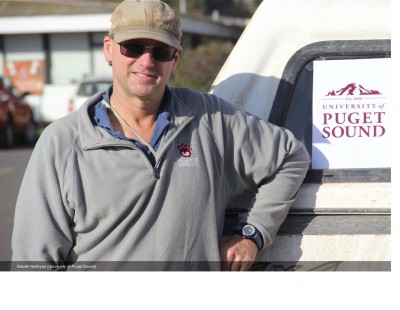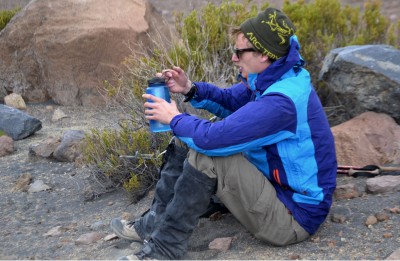Register Lecture is free and open to the public: 7:30 p.m. Thursday, Nov. 12, in Kilworth Memorial Chapel
TACOMA, Wash. – The more we understand about ice and snow, the little bit closer we move toward explaining and predicting climate change.
For that reason, Steven Neshyba, professor of chemistry at the University of Puget Sound, has been working independently and with an international team from Chile, Germany, and the United States to understand these chilly forms of H2O.
Next month Neshyba will share two avenues of his research and some of the answers he has discovered in the Regester Lecture “Ice Science in a Changing Climate.” The free public lecture will be held at 7:30 p.m. Thursday, Nov. 12, in Kilworth Memorial Chapel. Everyone is welcome, and no tickets are required.
“We think we have an answer,” Neshyba says, to at least one sticky question regarding the behavior of “ice clouds” or cirrus clouds. His team’s conclusion came at the end of a long path of research that he says was “pretty serpentine, with more dead ends than successes.”
The question about ice clouds arose in scientific circles when reality refused to align with the time theory. Cirrus clouds, which cover about 30 percent of the earth, play an important role in regulating the Earth’s temperature by scattering and transmitting light from the sun. However, when scientists flew through cirrus clouds, they found that the ice crystals reflected more light than theory said they should.
“A lot more,” Neshyba explains. “We’ve been exploring why that might be so. It has involved scanning electron microscopy, in silico radiative transfer experiments, Bayesian analysis, and molecular dynamics simulations. But we think we have an answer.”
Neshyba’s second line of research took place in the Chilean Andes, where an international team measured black carbon deposits in the snow that arise from regional cities and industry.
“We know that increased atmospheric carbon dioxide has been the main driver of climate change in the last 100 years or so, but a second driver turns out to be airborne black carbon emitted by vehicles, fires, and cookstoves,” Neshyba says. “If this black carbon lands on snow, the snow darkens and melts faster. Scientists have documented this process in lots of regions of the globe—except in South America, where much less work has been done.”
He adds: “We encountered some significant challenges along the way, including iffy roads, hiking at high altitudes, an abundance of dust, and one fierce snowstorm. But we have a start, at least, of a map of black carbon in the Chilean Andes.”
The lecture will explain the significance of these findings and touch upon other interesting facts about ice, such as the role it may have played in nurturing the beginning of life on Earth. The talk will conclude with some broader questions and remarks about the role of ice, ice science, and ice scientists in a changing climate. Questions from the audience will be welcome.
The John D. Regester Faculty Lectureship was established in 1965 to honor John Dickinson Regester's service, who joined the Puget Sound faculty in 1924. Register taught philosophy, served as dean of the university, and, in 1960, as the first dean of the graduate school. The lecture series is held in recognition of the scholarship and accomplishment of the speakers. It allows faculty members to develop ideas further and explore them with colleagues and the public.
To read more and see photos of the Black Carbon Campaign in Chile, visit: antarctica.cl/Outreach/Pages/Black_Carbon_Campaing.html
For directions and a map of the campus: pugetsound.edu/directions
For accessibility information, please contact accessibility@pugetsound.edu or 253.879.3236, or visit pugetsound.edu/accessibility.
Press photos of Steven Neshyba can be downloaded from pugetsound.edu/pressphotos.
Photos on page: From top right: Black carbon research co-collaborators Steve Warren, the University of Washington (left), and Michael Schrempf, Institute of Meteorology and Climatology, Leibniz University, Germany, collect snow samples; Andes Mountains in Chile; Steven Neshyba on site in Chile; student researcher Alec Pankow '15 takes a break. Photos by Raul Cordero and the Black Carbon Campaign team.
Tweet this: #Ice, its mysteries, what we know. Talk by Steven Neshyba @univpugetsound.edu Nov. 12 #climatechange #blackcarbon http://bit.ly/1GHms4e.
Follow us on Twitter! twitter.com/univpugetsound





